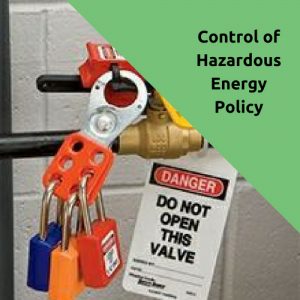Control of Hazardous Energy Program
 A control of hazardous energy program is very important for workplace safety, and is often overlooked in many workplaces. Many workplaces think they are exempt from the OSHA standards of controlling hazardous energy.
A control of hazardous energy program is very important for workplace safety, and is often overlooked in many workplaces. Many workplaces think they are exempt from the OSHA standards of controlling hazardous energy.
Control of Hazardous Energy, often just called Lockout/Tagout (LOTO), is the #5 most common cited OSHA violation.
While often misunderstood, or misapplied, OSHA 1910.147 spells out the applicability of the standard, along with the steps to perform LOTO.
The foundation of a Hazardous Energy Control Program is a policy that explains all aspects of the program, sets expectations of when LOTO is performed, and by whom.
Besides a policy there are other important components of a LOTO program, which includes:
- Training – for those performing Lockout/Tagout
- Training – for “affected employees”; defined as employees in a work area where LOTO is performed, who may be impacted by the action
- Annual retraining – Lockout/Tagout is not a set and forget program, it needs to include annual recertification for employees
- Machine specific procedures – these are documented procedures to perform Lockout/Tagout for each piece of equipment, and needs to be reviewed at minimum annually.
Do you need more components of a lockout/tagout program?
Besides the above components, the policy, training,machine specific procedures, and recertifications need to be performed every time a new piece of equipment is added to the workplace.
To learn more about OSHA 1910.147 Control of Hazardous Energy Standards, OSHA has a published booklet, which helps explain the concepts of the standard, but should not be used to as a substitue for the standard in it’s applicability to workplace safety. View the booklet here.
If you need to sell the concept of Lockout/Tagout to your superiors, as it does require a substantial investment in time, new safety equipment, and enforcement, CDC/NIOSH has a fact sheet that can be used to explain the standard and it’s importance for workplace safety. View the fact sheet here.
Failure to have a Lockout/Tagout policy, or even a suitable program, can lead to employee injury or death, and is a direct violation of the OSHA General Duty Clause:
a) Each employer —
(1) shall furnish to each of his employees employment and a place of employment which are free from recognized hazards that are causing or are likely to cause death or serious physical harm to his employees;
(2) shall comply with occupational safety and health standards promulgated under this Act.
(b) Each employee shall comply with occupational safety and health standards and all rules, regulations, and orders issued pursuant to this Act which are applicable to his own actions and conduct.
I offer 2 policies for Control of Hazardous Energy:
- Is a basic program, which spells out the base minimum of an OSHA compliant program, good for a workplace with minimal need for LOTO, such as one where contractors perform all the work.
- Is an advanced policy, in which every component of a quality program is spelled out, including Tagout only, lock removal, and discipline for policy violation.
